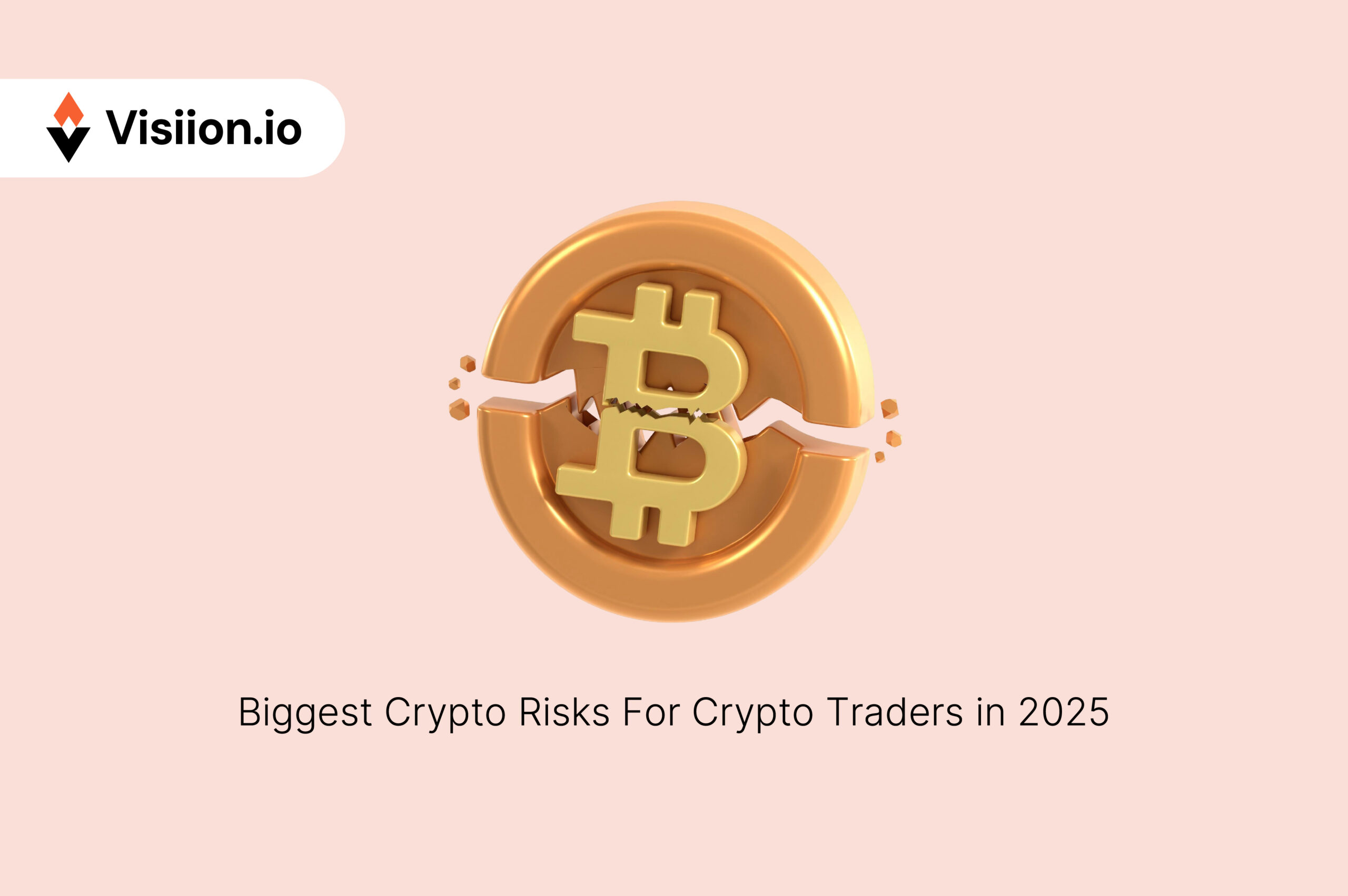Biggest Crypto Risks For Crypto Traders in 2025
We’re only halfway through 2025, and scams have already drained over $6.3 billion from crypto wallets worldwide. From deepfake-driven investment traps to fake exchanges posing as the real deal, this year’s fraud is smarter, faster, and harder to spot.
Romance-driven investment schemes are still draining millions weekly. Rug pulls linked to meme tokens have triggered single-day crashes, wiping out $300 million at a time. Even crypto ATMs have become laundering hotspots, with regulators in multiple countries flagging them as high-risk.
Scammers aren’t running basic tricks anymore. They’re using cloned exchanges, AI voiceovers, and forged KYC dashboards to appear legit. Traders are losing money like they have never before.
At Visiion.io, we want our users to stay safe from such fraudsters. So here we are, with the list of the biggest crypto risks that traders and investors are starting at in 2025. Safety starts from knowing the threat. And this blog offers the knowledge about such risks.
So, without wasting any time, let’s get started.
Romance & Investment Scams (“Pig Butchering”)
Romance-based crypto fraud scaled up in 2025. Scammers pose as attractive profiles on dating apps, Telegram, or Instagram. They talk for weeks, even months, building trust. Then, they introduce crypto as “a secret to making money together.” Victims follow their advice, invest in fake platforms, and see fake profits… until withdrawal requests trigger errors, fake fees, or total platform shutdown.
In just six months, US and Southeast Asian law enforcement reported over $2.9 billion lost to romance-investment scams alone. One Maryland woman lost over $3 million in April after believing she was investing with her boyfriend. The fraud ring she spoke with operated out of a scam compound in Laos, staffed by trafficked workers forced to run chat accounts round-the-clock.
About 40% of all crypto fraud revenue in 2025 came from these scams. Chainalysis confirmed it remains the fastest-growing financial scam model in crypto today.
Fake Trading Apps and Social Engineering
This scam feels like real trading. That’s the trap. It starts with a DM or ad featuring a celebrity, influencer, or financial “guru.” You’re invited to join a Telegram group where users post profits and screen recordings. Then, you’re asked to download an app that mimics a legit trading platform.
At first, you win. You can even “withdraw” small gains. Then you’re nudged to deposit more. Once you try to cash out real profits , the app crashes, the group disappears, or a customer support chatbot demands 20% in “tax.”
In Q1 2025, 87 deepfake-powered scam rings were busted in Asia alone. These apps often use AI-generated voices, fake news clips, and cloned UI designs to seem real. Victims across the US and UK lost over $850 million collectively between January and May.
Pump-and-Dump and Rug Pull Tokens
Scam tokens still thrive in 2025. You’ll see a coin pump 500% in 48 hours, backed by meme hype, political trends, or influencer “airdrops.” Telegram groups call it the next big thing. By the time regular traders buy-in, the dev wallets dump everything, crashing prices by 90% or more.
BANANAS31 USDT and another token tied to a fictional AI project pulled rug scams totaling $480 million combined in Q2. Argentina’s $LIBRA meme coin , endorsed by local influencers , reached a $4.6 billion market cap before the insiders dumped 70% of supply in one night.
On-chain analysis shows over 3,100 tokens launched in 2025 had clear rug-pull signatures: sudden volume, centralized holdings, and no actual utility.
Wallet Hacks and Private Key Theft
Most wallet breaches in 2025 come down to one thing: users trusting the wrong link. Scammers set up fake airdrops, browser extensions, or QR code scanners that prompt users to “connect wallet.” Once signed, permissions allow the attacker to drain funds.
In February 2025, Bybit got hit with a $1.5 billion hack, the biggest of the year. North Korea’s Lazarus Group exploited a server vulnerability and siphoned ETH over six hours before the breach was detected.
Crypto security reports show that 60% of all crypto hacks in H1 2025 involved compromised private keys or phishing dApps. Even experienced users fell for “staking upgrades” that led to wallet drains. Total value stolen so far this year? Just over $3.2 billion globally.
Crypto ATM Scams
Crypto ATMs now play a big role in scams. Here’s how it works: fraudsters call or message the victim, claiming to be from the IRS, police, or a loan officer. They create panic , unpaid tax, frozen bank accounts, and legal charges. Then, they tell the victim to deposit money at a Bitcoin ATM to “resolve” the issue.
The victim follows instructions, scans the QR code, and sends cash. Once that transaction is confirmed , it’s gone.
In Australia, victims deposited over A$3 million into ATMs used in scam operations within the first half of 2025. One woman lost A$430,000 alone after being manipulated by a romance-cum-investment scam. Over in the US, regulators reported $120 million routed through ATM-linked frauds , mostly targeting seniors.
Some law enforcement agencies are now physically cutting open machines to recover locked wallets used in scams.
Fake Technical Support Scams
You Google: “MetaMask not working.” The top result? A fake support site. You click it. A pop-up appears. You chat with “support” and explain your issue. They ask for your seed phrase to “verify ownership.”
The moment you paste it, they empty your wallet.
In other cases, users post on Reddit or X about being locked out of their account. Within minutes, scammers reply with a fake support link. Some victims get redirected to WhatsApp or Telegram, where they’re promised help , but end up paying a “gas fee” just to watch their wallets get drained.
In 2025, the FBI logged 7,500+ senior victims of this scam type. Losses in the US alone crossed $900 million by May. Many of these were tied to hybrid scams, blending fake tech help with emotional manipulation and investment hooks.
Legal and Regulatory Blind Spots
Scammers love gray zones. In 2025, those zones still exist in most of the world.
According to FATF’s April 2025 update, only 40 of 138 countries were “largely compliant” with crypto AML/CFT standards. That means cross-border wallet transfers, mixer transactions, and exit swaps still move under the radar , especially through decentralized bridges.
Scam tokens continue launching in jurisdictions with weak KYC enforcement. ATMs stay unregulated in large parts of Asia and Latin America. Even regulated countries struggle to enforce scam shutdowns because fraud rings use shell domains, foreign hosting, and Telegram for ops.
Meanwhile, banks and exchanges keep flagging accounts , but once the funds exit, tracing them becomes a needle-in-a-mixer problem.
Crypto Scams in Numbers
- An estimated $51 billion flowed into illicit crypto wallets in 2024.
- Around $40 billion got laundered.
- Scam wallets pulled in $12 billion.
- Hacks stole $2.2 billion.
- US scam complaints more than doubled in 2024; over 150,000 complaints were filed. Seniors lost the most; romance and investment scams cost Americans $5.8 billion.
- Deepfake fraud caused roughly $12 billion in losses globally; projections say it could reach $40 billion in a few years.
How to Stay Safe?
Look, staying safe from these scams is not rocket science. All you have to do is stay aware and control your greed! Here are some important steps that can help you stay safe:
Vet every person or platform closely
Never trust unsolicited messages. Search the real company website. Read verified reviews. Reach out to official support. Clone scams use fake likenesses and brand logos.
Never share your seed phrases.
Support teams never ask for private keys or 12-word recovery phrases. If someone asks, it’s a scam immediately.
Avoid unknown tokens
Check token ownership distribution. Avoid tokens that rise 300% in days. Stay away from rug-pull red flags like founder-owned supply and anonymous dev teams.
Use regulated exchanges
Stick with platforms that enforce KYC/AML. Watch for regulatory reports, some jurisdictions still lag FATF standards.
Skip crypto ATMs in scams.
If someone tells you to deposit cash at ATMs to recover or invest crypto, hang up and verify with a trusted party. Regulators flagged ATM losses in multiple countries as massive red flags.
Double-check “mentors” or investment channels.
If someone pressures you to move your money fast, claims insider knowledge, or encourages you to invest more after small gains, pause and consult a friend or regulator. Fake trading communities lure investors via fake initial profits.
Enable strong security
Use hardware wallets or cold storage. Activate multi-factor authentication on your exchange. Monitor accounts for unusual logins.
Report and document scams fast
If you suspect fraud, contact local cybercrime units. Save messages, screenshots, and wallet transaction IDs for investigators.
Stay Aware
Follow official reports from sources Chainalysis, AUSTRAC, FINRA, NASAA & Visiion.io. Learn about emerging scams like deepfake phishing, AI-powered clone profiles, or Ponzi tokens tied to political figures.
Wrapping Up
As the number of crypto investors and traders rises, it is going to be a fertile ground for fraudsters. So, it’s very important for traders and investors to choose the right platforms like Visiio.io. Look, crypto fraud remains highly organized, massive in scale, and evolving fast.
Romance scammers groom victims emotionally. Clone apps and deepfake voices pretend authority. Pump and dump tokens crash portfolios. ATM cons target seniors. Shadow call centers lure victims globally. Smart traders learn the fraud patterns, follow clear safety rules, and never let confidence create vulnerability.
We hope this guide on Crypto risks has offered you enough idea of where to look and what to look for. So, stay safe, invest smart, and keep growing.









